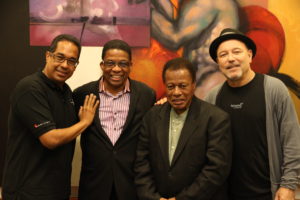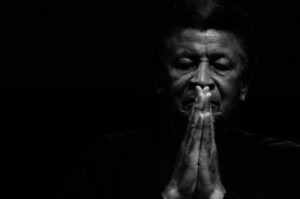Wayne Shorter had an emotionally taxing life, which inevitably coloured his tone on the saxophone
A
About eighteen months ago*, I attended the 80th birthday celebration for the jazz legend, Wayne Shorter at the Antibes Jazz Festival on the French Riviera. Apart from a slight paunch, he looked not a day older than 60. His face was unlined, his posture ramrod straight, a full head of hair without a speck of grey. He opened the set with Orbits, stroking the tenor saxophone like a painter at work, laying out the palettes which would later transmogrify into a resonant mosaic.
He was followed on stage by Wynton Marsalis playing with a sizzling 40-piece Lincoln Centre Jazz Orchestra, but I must confess, I could no longer hear anything else that evening. Shorter’s mellifluous tones on Orbits and Joyride lay on my mind and inner recesses like drying paint on a canvass. I was rendered tone deaf after that, totally subsumed and submerged into his artistic and improvisational aura. It was a quasi-religious experience.
 Wayne Shorter on the cover of his album Odyssey of Iska, released on Blue Note Records in 1971
Wayne Shorter on the cover of his album Odyssey of Iska, released on Blue Note Records in 1971
In this regard he was no different from another saxophone colossus, the great Sonny Rollins, who had played the same festival a year before, at 82. Rollins had strode on to the stage, like well, a colossus, and proceeded to hold court for an entire two hours, and had everyone on their feet with his orgiastic rendition of his timeless Don’t Stop the Carnival.
In New York City, in the early 1990s, we used to wait with much anticipation for a Sonny Rollins “sighting”. He had made a ritual of playing every two years in one of New York’s premier concert venues such as Carnegie Hall, Avery Fisher Hall and the Beacon Theatre. This was a major event in the jazz calendar. He would invite any of the dominant saxophonists of the day, be it Branford Marsalis or Joshua Redman on stage to jam with him, and proceed to give them a masterclass on the art of the tenor saxophone. I remember a concert in 1995, where he jammed with the bebop great Jackie McLean, a childhood amigo of his from the same Sugar Hill neighbourhood in Harlem. They went toe to toe, note for note, riff for riff, in a mesmerising jamming jamboree. For once, Rollins did not land his usual knockout punch. On that evening, in McLean, Sonny Rollins had met his match. The contest ended in a deuce. Seventeen years later he had lost none of his groove and swagger.
 Danilo Pérez, Herbie Hancock, Wayne Shorter, Rubén Blades at the Panama Jazz festival in 2013 (US Department of State)
Danilo Pérez, Herbie Hancock, Wayne Shorter, Rubén Blades at the Panama Jazz festival in 2013 (US Department of State)
What both Shorter and Rollins had in common is a deep spirituality. Shorter is a Nicherin Buddhist, a spiritual practice credited for turning his difficult and painful life around. Rollins is a yoga practitioner who has dabbled in Zen Buddhism. Shorter had a particularly sad life. His first wife, Irene, left him and would later date and marry the actor, Billy Dee Williams, of Lady Sings the Blues fame, who had been a neighbour of theirs (go figure). His father had died in a car accident while driving from his concert in the midst of this marital meltdown. His daughter with his second wife, Anna Maria, was born with severe brain damage, a pain that would lead both of them to alcohol abuse. She would later die at the age of 12. And, as if that was not enough pain for one individual, Anna Maria would perish on that fateful TWA plane crash on July 18 1996, off the coast of Long Island, New York.
By any measure, this has been a challenging life. But encouraged by his friend, the pianist Herbie Hancock and his wife Gigi, longtime practitioners of Buddhism, he began to find solace and equanimity with this spiritual practice, a wellspring for the resplendent glow that has been his hallmark lately. It also enhanced the breathtaking creativity that prompted The New York Times to salute him as “jazz’s all-round genius, matchless in his field as a composer, utterly original as an improviser”.
His music with his longterm quartet of Danilo Perez on piano, John Patitucci on bass and Brian Blades has begun to rival his fabled musicianship as the music director of Miles Davis iconic quintet in the 60s, when he penned some of jazz’s most iconic compositions such as Footprints and Nefertiti. Many had thought his work with Joe Zawinul as cofounder of the group Weather Report, following the Miles era, would be the swansong of his compositional and artistic valence. But he seems to be getting better like the proverbial vintage wine.
This brings me to another wondrous phenomenon; that of Hugh Masekela who, at 75, seems to be scaling the heights of his artistic prowess. He’s hipper, stronger and nicer. I recently had a chat with him about Tai Chi, which he has been practicing for the past 10 years. He waxed rapturously about this practice, and its imprimatur was palpably evident in his wholesome disposition and exuberance, after years of self-confessed nihilism and hedonism.
Ditto with Abdullah Ibrahim, an 8th Dan martial arts expert and devotee of Islam, who turned 80 last October, but can kick anyone’s ass, literally and figuratively. Watch him walk on stage, regal in bearing, serene in demeanour, looking “too cool for school” in his customary “all black” regalia and then the music seems to ooze seamlessly from his fingertips.
 Abdullah Ibrahim remains regal in bearing and serene in demeanour (Georg Seldmeir)
Abdullah Ibrahim remains regal in bearing and serene in demeanour (Georg Seldmeir)
But the one who would surprisingly elude wellness’s grip was Zim Ngqawana. I had known Ngqawana since my return to these shores in the late 1990s.We were a group of “cats” who were part of the Bassline jazz scene and local food joints in Melville, Johannesburg. He was into yoga, meditation and vegetarianism. He combined a deep spiritual sensibility, an amalgam of Sufi mysticism and New Age syncretism and an artistry that exploded from his entire being. But by all accounts, after his farm in the south of Johannesburg was ransacked and his half-a-million-rand-worth Steinway grand piano desecrated, his mood towards life would darken insuperably, a prelude to the stroke that would take his life at just 51 years of age. It seems all his spiritual and emotional resources would prove supine against the silent seductions of the Grim Reaper.
The Ngqawana riddle notwithstanding, Shorter and Rollins’ example and Bro Hugh’s personal and artistic renaissance seem instructive for an artistic community under siege. From Kippie Moeketsi to Pat Matshikiza; Victor Ntoni to Moses Molelekwa — it’s been an avalanche of blues for this community. One does not want to downplay the socio-economic factors at the heart of these blues, and privilege a spiritualist reductionist logic. But there is ample proof to suggest that the spiritual bliss that devotional practice, wellness and meditation fosters would be a critical resource for jazz’s “fightback” against the demons of alcohol and substance abuse, poverty and the marginalisation of a society in transition, preoccupied with other concerns.
* This piece was originally published in 2015, as a look at spirituality and jazz. It has been republished for International Jazz Day, which is celebrated annually on April 30